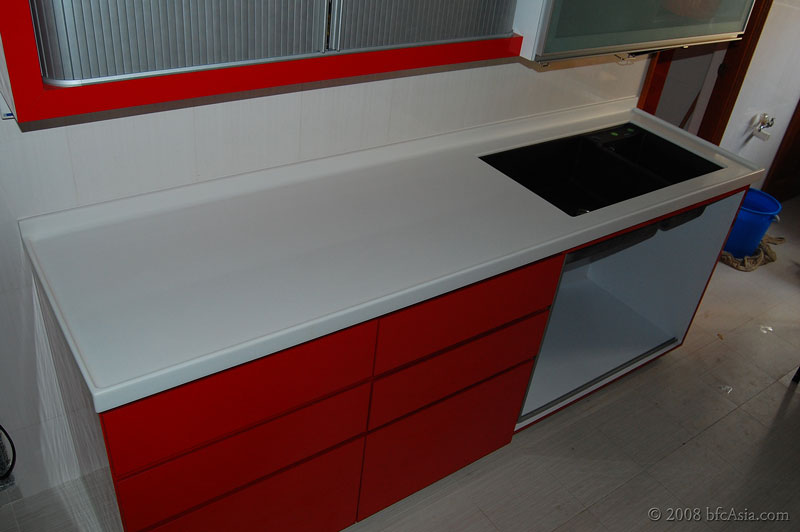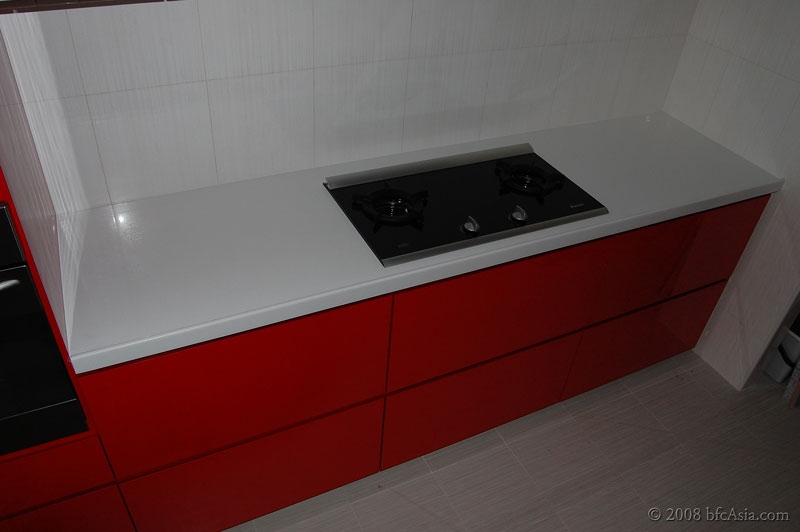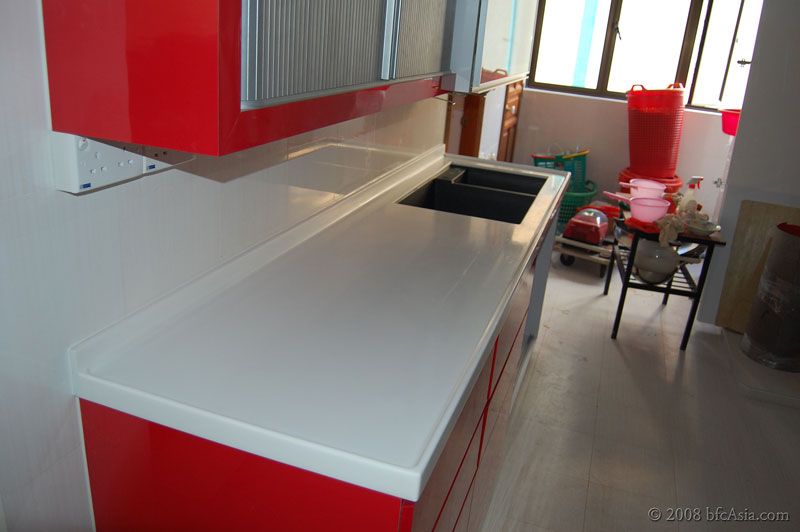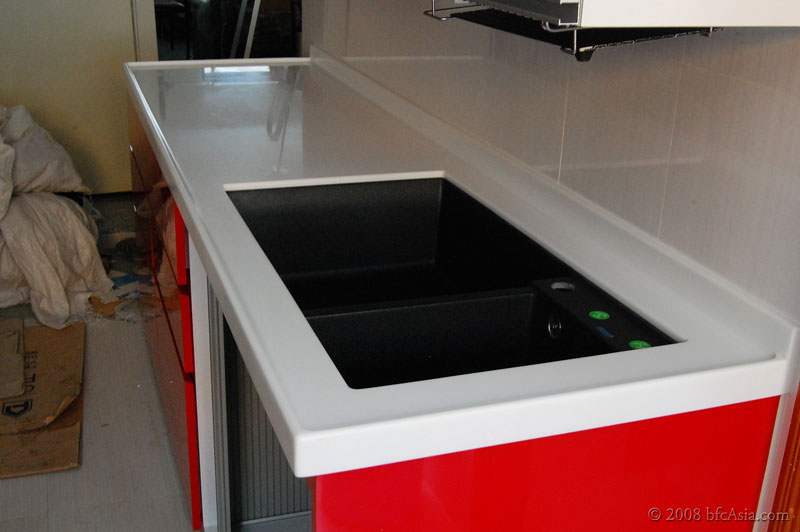1 How to Choose: Kitchen Worktop
2 My Acrylic Worktop
3 Verdict: My Asuka Acrylic Worktop
4 DIY: Worktop Protector
5 Further Reference
6 Silestone FAQ
7 Maintenance: Granite Worktop
Note: This is an update of an older article.
In deciding what kind of worktop I should get for my kitchen, I used the following criteria, in no particular order of importance:
- Resists heat, stains, scratches
- Easy to maintain
- Durable
- Beautiful
- Affordable
A note about "affordable". I am using that term in the subjective sense here -- "affordable" does not equate to "cheap" or "expensive" per se.
Our acrylic worktop is affordable, durable, pretty, easy to maintain

To me, a worktop that costs $4,000 and lasts a lifetime is cheaper than another that costs $1,000 and lasts say, 5 years, all other things being equal.
If the worktop is easy to maintain, looks good, and lasts a long time -- that worktop is affordable to me. I am pretty laid-back and hate to expend time, effort and money to replace a functional worktop when it is serving its purpose well day-in, day-out. So in that sense the $4,000 worktop is affordable to me, the $1,000 worktop is not. Not because of price, but because of my value system.
Thus someone who values the latest trend or latest innovation in worktops will find the $1,000 worktop "more" affordable because he will probably replace his worktop within 5 years. Sure, he too can afford to buy the $4,000 worktop -- but price is not the issue here. The term "value for money" encapsulates the idea.
Granite, Silestone, Slate & Other Stones
Initially I was drawn to granite: it is beautiful, hard-wearing, and long-lasting. Or so I thought.
Not so, said users who have had used granite worktops. Reason? Granite is not a homogeneous stone, there are fissures and areas of high stress in the rock. Some users reported their granite tops developed cracks after about 5-8 years of usage. Therefore hot pots and pans should not be placed directly onto the granite worktop, but on trivets or other protection placed atop the granite surface.
Also, contrary to what I thought -- granite is porous! Simple test: pour water on a granite floor, wait a few minutes and then wipe off the excess water. You will see the granite tile become much darker than another adjoining tile that is dry. That is because water was absorbed by the granite tile when you poured water onto it.
Owing to its porosity, the granite dealer advised me not to use any chemical to clean the granite floor, just plain clean water will do.
Likewise, granite worktops may absorb stains depending on how porous that particular area is. Depending on luck, you may get a top which is impervious and that is fine. In any event, granite used in worktops should be sealed and maintained regularly, with re-sealing once every 5-6 months to maintain the worktop in pristine condition.
Silestone offers the least maintenance, but not everybody like the colors or patterns available, although the premium range looks real beautiful to me. Locally
I shall not go into slate, sandstone or other natural stones that are also used for worktops.
Acrylics
Corian, like other acrylic-based worktops, has its share of maintenance issues too. They stain badly. If you don't believe, rub tumeric powder or yellow ginger onto the surface, then try to clean off the stain after 5-10 minutes. Also, some users experienced rings on the top after placing hot pots and pans directly on the surface.
Hence, acrylics' maintenance is no more arduous than natural stones', probably less as no regular re-sealing is required. As for heat and stains, the care needed to maintain the worktop in pristine condition is the same as natural stones. Acrylics however is softer than natural stones and scratches more easily. That same hardness attribute makes it easier to remove scratches too.
When we first installed our Corian worktop 20 years ago we didn't know better, and believed everything the product literature said. Such as "heat-resistant" which we took to mean we could carelessly place hot objects on the worktop. Or "stain-resistant", which meant we didn't have to wipe off curry-paste spills immediately.
One other point: acrylic worktop like Corian may "yellow" with time, particularly if your worktop is a lighter color such as cream or white. My old worktop was a light sand color: it showed its age after 9-10 years. Darker patches also developed with time near the microwave oven, probably as a result of placing hot containers there after taking them out of the microwave.
Acrylic worktop made-to-order and custom-fitted to cabinet base

Sinks moulded from one piece Corian or acrylic top? That used to be the rage a
Others
Solid glass worktop seems to be a recent innovation, similar to Silestone. However, worktop glass needs to be custom-ordered and the kitchen skilfully designed to bring out glass' appeal (read: lighting techniques). Locally, I believe glass worktops are not available yet because special installation skills are required.
Some use cement worktops successfully, some use tiles, Formica, even stainless steel. Others use solid wood worktops such as those from Ikea which are beautiful but seem to have been surpassed in popularity by acrylics and natural stone.
Summing Up
Now, after looking at several different materials for the kitchen workshop and their attributes -- such as solid glass, solid wood, granite, marble, acrylics, silestone, cement, tiles, etc -- I finally decided on a simple acrylic worktop for my new kitchen.
Acrylic worktop is easily lifted up without damage to underlying cabinet base

Why so? Well, let me share my findings, which are by no means exhaustive. They may also not be applicable in your case, because of differing values, as mentioned earlier. So no offense intended!
Resistance to stain, heat, scratches - No single worktop material meets all three requirements satisfactorily e.g. acrylics are affected to some degree by heat, stain, and scratches -- despite what the promotional blurbs say.
Even Silestone, which requires least maintenance, needs careful placement of hot pots and pans to avoid thermal stress. The following was extracted from a leading US producer of Silestone under its Care and Maintenance section:
QUOTE:
CAUTION
The following will harm Silestone Quartz: Drano®, Liquid Plumr®, oven cleaners and floor strippers. Do NOT use these or any other harsh chemicals on your Silestone surface.
CAUTION
Do NOT use crock pots or electric skillets while in direct contact with your Silestone surfaces. Always place them on a trivet or cutting board to protect your countertop. (Review your electric appliance manual as a reference.) Silestone is a stone product. As with any natural stone, certain exposure to heat may cause cracks due to thermal shock.
UNQUOTE
Durability, beauty, easy to maintain -- All worktops, no matter what material they are made of, are beautiful and durable, provided care is taken in maintaining them.
That means:
- don't place hot pots and pans directly on the worktop surface
- wipe up stains and liquids on the worktop surface immediately
- clean, dry, and polish the worktop surface at the end of the day
- if sealing is mandated, apply sealer regularly as recommended by the dealer
Given the above, my conclusion is an acrylic-based worktop. It requires no more (in fact, less) maintenance and care than worktops of natural stones or other materials, yet is as beautiful and durable as the others.
And since I cannot find any unique benefit in using Corian over other acrylic worktops, I simply went for a custom-made acrylic worktop produced by Asuka, a local factory.
Judge for yourself whether the worktop looks more or less beautiful than Corian

To us the acrylic worktop looks the same as any other acrylic-based worktop such as Corian. Value for money indeed !
ADDENDUM
13-May-08 : After reaching home from shopping at Sheng Siong, we placed the plastic
We tried using soap, and when that failed to remove the stain, we used Lemon Pledge that was recommended by the worktop guys previously. The blue stain came off a bit but did not disappear entirely. Finally we tried thinner, and viola! the stain was removed.
So keep a bottle of thinner that may be purchased from any hardware shop in the kitchen.
Related Posts
1 How to Choose: Kitchen Worktop
2 My Acrylic Worktop
3 Verdict: My Asuka Acrylic Worktop
4 DIY: Worktop Protector
5 Further Reference
6 Silestone FAQ
7 Maintenance: Granite Worktop











